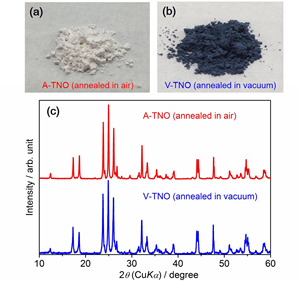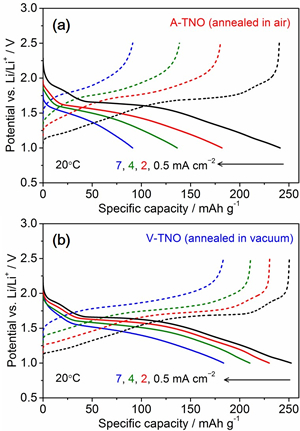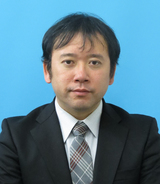
ここからコンテンツです。

High power and high safety materials for Li-ion battery
Vacuum-annealing improves electrochemical performance of Ti-Nb mixed oxide negative electrode for Li-ion battery with high safety By Ryoji Inada
Ryoji Inada, and his colleagues at Toyohashi University of Technology, have successfully demonstrated that electrochemical Li insertion and deinsertion property of Ti-Nb mixed oxide Ti2Nb10O29 (TNO) at high current rate is greatly improved by vacuum annealing. This is mainly attributed to enhancement of the intrinsic electronic conductivity of TNO by introducing oxygen vacancy. Vacuum-annealed TNO is promising negative electrode material of high power and high safety Li-ion battery for large scale application.
Mixed Ti-Nb oxide Ti2Nb10O29 (TNO) is one of the negative electrode materials used in large scale Li-ion batteries with a high degree of safety because the potential (= 1.6 V vs. Li/Li+) for Li storage of TNO should avoid the possible risks of Li plating or formation of Li dendrites as well as short circuiting of the battery igniting the flammable organic liquid electrolyte.
TNO shows the reversible capacity of 250 mAh g-1 at low current rate and good cycle stability. However, TNO is an insulating material and its electronic conductivity is quite low, which leads to poor electrochemical performance at a high current rate.
Ryoji Inada , Yoji Sakurai , and their colleagues at the Department of Electrical and Electronic Information Engineering, Toyohashi University of Technology, have shown the improvement of electrochemical performance of TNO at high current rate by means of vacuum annealing.

The photos and X-ray diffraction patterns of TNO annealed in air and vacuum are compared in Fig. 1. Although the crystal structure is not changed by the different annealing atmosphere, the color of TNO is changed from white to dark blue by vacuum annealing, indicating the presence of the mixed Ti4+/Ti3+ ions.
Thermogravimetric analysis clearly shows that a small amount of oxygen vacancy is introduced by vacuum annealing, which causes partial reduction from Ti4+ to Ti3+ in TNO. By addressing this fact, vacuum-annealed TNO (V-TNO) shows much higher electronic conductivity (10-6-10-5 S cm-1) than air-annealed TNO (A-TNO) at room temperature.

Fig. 2 shows a comparison of the charge and discharge curves of both A-TNO and V-TNO electrodes at various fixed current densities per unit electrode area of 0.5, 2, 4 and 7 mA cm-2. The charge and discharge capacities for both electrodes are decreased monotonically with increasing current densities, but V-TNO shows larger capacity than A-TNO under the current density above 2 mA cm-2. This tendency becomes more remarkable as the current density is increased.
The improved electrochemical performance of V-TNO electrode at high current rate is mainly attributed to the enhancement of its intrinsic electronic conductivity. V-TNO can potentially be used as a novel negative electrode material for Li-ion batteries capable of high power and high safety for large scale applications such as hybrid electric vehicles and energy storage systems.
Reference
- Takashima, T., Tojo, T., Inada, R., and Sakurai, Y. (2014). Characterization of mixed titanium-niobium oxide Ti2Nb10O29 as anode material for lithium-ion battery. Journal of Power Sources,276, 113-119. doi: 10.1016/j.jpowsour.2014.11.109
Researcher Profile

| Name | Ryoji Inada |
|---|---|
| Affiliation | Department of Electrical and Electronic Information Engineering |
| Title | Associate Professor |
| Fields of Research | Energy Conversion Engineering / Electirical and Electronic Material Engineering / Non-Destructive Testing |
Researcher Profile

| Name | Yoji Sakurai |
|---|---|
| Affiliation | Department of Electrical and Electronic Information Engineering |
| Title | Professor |
| Fields of Research | Energy Conversion Engineering / Electrochemistry |
ここでコンテンツ終わりです。
